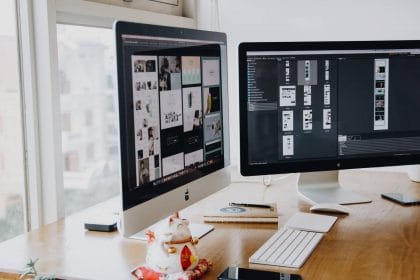We all know what minimalism is. A luxury store’s front window with white walls featuring one stunning black cocktail dress, Google’s homepage. There’s usually a lot of white involved in minimalism. Maximalism, on the other hand, while being theoretically the opposite of the minimalist style, isn’t necessarily about clutter or excess. It is, however, visually and spatially busier. Maximalist style is about bold colors, patterns, and creativity. It fills a room with interest and variety. White cotton sheets versus silk paisley ones.

Once web design exited the infant stage and designers had the tools and know-how to experiment in this medium, they spent a lot of time and effort trying to replicate the real world on websites. Out of this understanding, the first impulse of maximalism was felt. It was an impulse to exert maximal effort, to pour every ounce of knowledge and technical wizardry into their work.
Skeuomorphism is the design concept of making items represented resemble their real-world counterparts. The most famous example of this trend are the realistic backgrounds and icons that were carefully, and with great skill, illustrated to represent physical objects. Designers spent countless hours agonizing over the smallest details of skeuomorphic web components.
Then, almost overnight minimalism arrived. One day, designers were consumed with crafting touchable 3D buttons and the next they were actively repulsed by the sight of a drop-shadow.
Flat, simple, streamlined. These are the commandments of our craft today, but such mandates stifle the very creativity that makes designers essential to the development of digital products.
Contemporary web design relies heavily on minimalistic sensibilities, but at what cost to our industry’s creative progress?
Many in the industry believe that minimalism is synonymous with good user experience and that maximalism will automatically impede that goal. Minimalism is often used as a shortcut to a good experience; its basic tenets of negative space and simplicity allow users to more easily achieve their goals almost as a byproduct. Even a small, gray button is hard to miss floating in an ocean of white.
Yes, good minimalist design may require careful consideration, but minimalism is easy to replicate once it has been mastered. It’s also a doddle to emulate with relatively little skill.
Consider the famous little black dress. So chic, so elegant. But it also takes very little effort or thought to buy and wear. You may look good—but you will also look like every other woman at the party.
What Is Minimalism?
Minimalism is about getting rid of excess. Minimalism is about using only the things you really need.
Minimalism stems from the idea that less is more. By putting only the most important things into a space, it makes those elements stand out more. That way, those things have the space they need to shine and play a visual role in an environment. Minimalism isn’t about using nothing, it’s about using only what really matters.
With a focus on clean lines, neutral colors, and basic textures, it’s a very versatile way of designing a wide range of things.
By using colors, tones, and textures that are neutral and can work in nearly any combination, the power of minimalism is unlocked. It’s versatile. Small, subtle changes can be seen easily and it takes less work to do so.
What Is Maximalism?
Maximalist design is defined by the following characteristics:
- Bold color combinations
- Contrasting patterns and motifs
- Repeated elements
- Little white space
- Layered images
- Dense text and multiple fonts
Maximalism, in contrast to minimalism, requires all of a designer’s wiles and knowledge of color theory, layout, UX, and content structure to effectively pull off. There’s nothing hard about putting a block of black text next to a slightly off-center floating image. But the degree of difficulty increases exponentially when there are five fonts, six colors, and treated images to manage. How do all these elements coexist in a design that is pleasing and unique but equally useable? The challenge is much steeper.
Maximalism is a no-holds-barred approach to design that involves embracing excess, getting loud, and adding distinctive visual flair to your site.
While it runs counterintuitive to the minimalist dogma pushed over the past decade, maximalism in your web design does come with certain advantages.
While minimalist design can be useful, not every style is right for every website.
Maximalist design can convey specific ideas that less aggressive aesthetics can’t. After all, the point of your web design is to showcase your brand’s identity, and just because “lean and mean” is hot right now doesn’t prove all other styles invalid.
Some websites have used maximalism concepts to create unique brand identities that definitely stand out from the crowd.
At the end of the day, minimalism isn’t the quiet genius and maximalism isn’t the proverbial stepchild. Both have their places and, if done well, both can be extremely effective in turning heads and garnering clicks on well designed websites.



